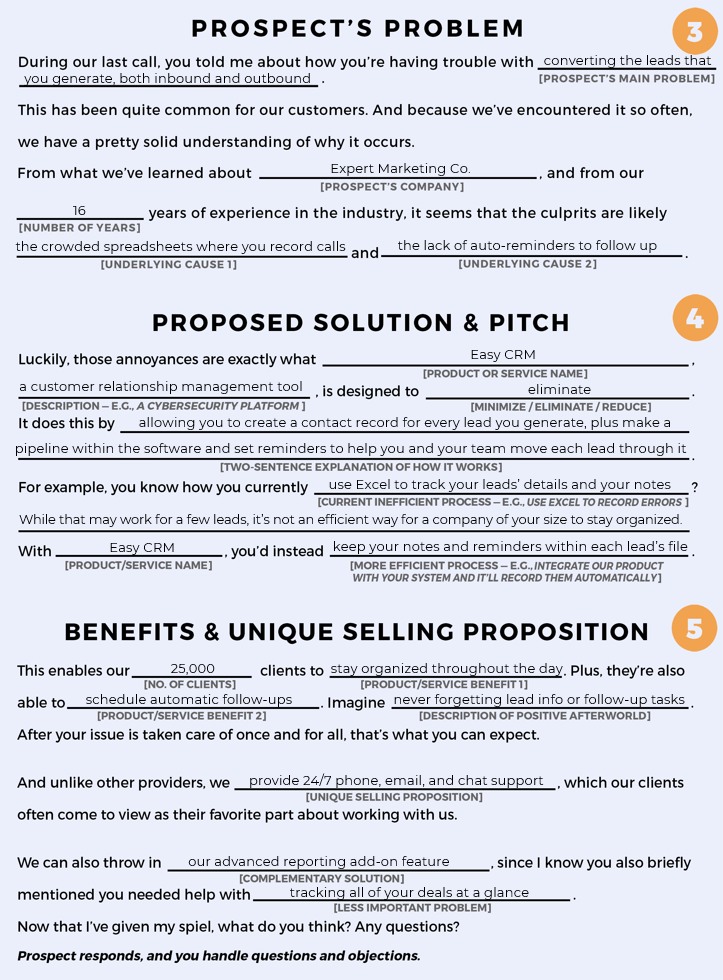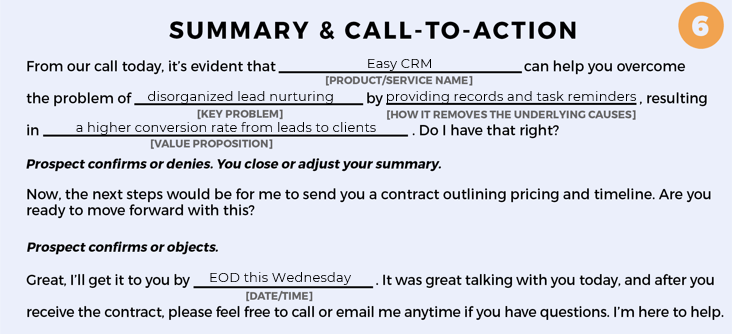Learn the differences between leads, prospects, and opportunities. Understand how to turn leads into prospects and opportunities.
A sales call is a phone or video call that you arrange with a prospect so you can give your full pitch to them for the first time. The goal of the call is to get closer to closing a sale by getting the prospect interested in moving forward and planning next steps such as a demo, presentation, proposal, or contract. To make a successful sales call, there's a five-step process to follow, plus tips to keep in mind throughout the conversation.
In the sales community, a sales call is usually a scheduled call with a qualified prospect where you give your first full sales pitch — this article will focus specifically on this pitching call. Because the term “sales call” is so broad, however, some people might use it to refer to other types of calls throughout the sales process.
Below are the main types of calls you'll encounter as a salesperson, in the order they typically occur:
In the rest of this article, we’ll elaborate on the third bullet point above: how to pitch your prospect on a sales call. The first step to learning how to deliver this type of sales call is understanding the common structure of the call. Below, we’ve listed the structure and given you a simple template that includes each component.
To help you have better sales calls, we've written a sales script article that provides a free sales call script template along with instructions on how to fill it out. You can also download the same template below, which follows the basic sales call structure: first an opener, then agenda-setting, a problem and solution, and your USP, and finally a call-to-action for next steps. You'll also receive five free niche-specific script examples to help you craft your own.
A sales call is successful if it pushes a prospect closer to a purchase. This can mean closing the deal on the call or scheduling a meeting, such as a presentation or proposal review. To have an effective sales call, you must do your research on the prospect to create a personalized call script that you’ll use to guide the call toward your desired outcome and plan next steps. Below are the five steps to making a sales call, which include researching your lead, then preparing and executing your script:
Next, we’ll go further in depth on each of the steps above so that you can be prepared to excel on your next sales call.
Look over your notes from previous interactions with the prospect and do some outside research. This will help you create a sales pitch tailored to their needs. When you make them feel like your product will solve their specific issues, they'll be more likely to buy it.
Research this key information about each prospect before writing your sales call script:
The more background information you have on your prospect, the more knowledgeable you’ll sound. Having this research on hand will also help you if you get unexpected questions or objections and have to frame your responses in ways that are tailored to the prospect and their situation. Once you have sufficient information on your prospect, it’s time to write your script.
A sales call script is a written document that outlines the flow of your sales call. The purpose of a script is to keep you on track to hit your key talking points. It’s your choice how comprehensive you want to make the script. It could outline simple talking points, or it could include paragraphs you’ll memorize and say verbatim — throughout the next few steps, we'll use our free script template to elaborate on this longer script option.
Here’s a talking-points-only sales call script you might write down before a call:
Because sales calls are two-way conversations, it’s impossible to plan every moment of the call. Salespeople will commonly write down and memorize the opening line, sales pitch, and closing statement. The rest of the script will just be steps like “share agenda” or “ask if they have questions,” similar to the script above. A script might also include rebuttals to common objections or answers to common questions so you can provide quick, polished responses.
Having either a full script or a rough layout of the structure of your sales call is essential. It separates the all-stars from the pros. Winging it is a risk. Having a clear vision of where you want to end up and knowing the steps you’ll take to get there will lead to sales calls that produce your desired results.
Your opening sets the tone for the rest of your call. Come off as personable by kicking off small talk, which will build some positive vibes. After a few minutes of chatting, transition into your agenda, which will inform the prospect of what to expect and put them at ease. Here is the best way to open a sales call:
Aim to finish the opening section of your call in five minutes, keeping your verbiage brief. Below, we've filled out our free template to provide an example of this quick, straightforward verbiage:

Now that you’ve warmed up your prospect, it’s time to crank up the heat and deliver your personalized sales pitch, including the problem, solution, and USP.
Your sales pitch is the meat and potatoes of the sales call. It’s when you express the value of your product or service by explaining how it will solve your prospect’s problem. Although it’s the most important part, it shouldn’t necessarily be the longest. In fact, it’s best to keep it under two minutes. If the prospect interrupts with a question, you can go longer. But avoid speaking for more than two minutes uninterrupted, as the buyer might lose interest.
Here are the steps of an effective two-minute sales pitch, plus an example:
Here are the steps in action in our sales call template:

After you’ve delivered your pitch, you might open the floor for questions. This is typical among sellers with longer sales cycles and more complicated, expensive solutions. But if you feel like your pitch is self-explanatory, transition directly into the CTA. Note that some businesses might use a product demo, where they show the prospect the solution after they give their basic pitch. This is most prevalent among software salespeople.
Your next steps depend on your sales process. It could be a close, another one-on-one meeting with this prospect, a larger meeting to present to other decision makers, or another step according to your sales process. State the next steps clearly and ask the prospect to agree, like this verbiage from our sales script template:

If the prospect agrees, schedule the meeting right there on the call. If they voice objections, stay calm, pause, and practice effective objection handling. Instead of responding aggressively, attempt to start a two-way conversation about their hesitation by asking them questions and digging deeper. Once you feel like you fully understand their objection, state your rebuttal, then bring up your CTA again when it seems that they're more comfortable.
If the prospect doesn’t answer your scheduled call, leave a voicemail. In a friendly tone, state that you’re here and will stay online (for video calls) or be available (for phone calls) for 15 more minutes. Also, tell them how to join the meeting, whether that’s calling this number back or clicking the link in your calendar invite. If after five minutes they’re silent, send them an email reminder. If after 15 minutes they’re still unresponsive, send another email proposing dates and times to reschedule.
Sometimes it can be hard to remember everything you need to do to get ready for a sales call. Here’s a checklist you can use for all the necessary preparation. Reference it either as a guide as you prepare or as a way to double-check your prep shortly before your call to ensure you're fully ready:
After you’ve done all the above, you should be ready to deliver an effective sales call that gets your prospect excited to work with you.
Below are some tips to ensure that your call goes as well as possible. These include scheduling your calls for the right time, saving pricing talks for the end (after establishing value), speaking like an executive, using video conferencing software to build trust, and recording your calls afterward to stay organized.
Nailing your sales calls will take time, but using key tips like these can help you come across as a confident sales caller to your prospects more quickly. In time, you'll start to feel like an expert, which will further help your chances of having great calls.
While some sellers use the term "sales call" to refer to a cold call, a sales call is typically a scheduled phone or video call between you and a warm, qualified lead. The purpose of the call is to nurture them and get them to agree to next steps, such as reviewing a business proposal. A cold call, on the other hand, is a phone call that you make to a lead who hasn't yet spoken with a member of your sales team; the goal is usually to set up a longer discovery call to measure fit.
Regardless of where it falls in your lead nurturing process, the sales call is when you first deliver your full sales pitch to a qualified prospect in order to move them toward a close. An effective sales call will include a rapport-building opening, a personalized sales pitch, and a close in which you ask them to take next steps with you. Now that you understand the basics, get started putting together a personalized script for your next scheduled sales call.